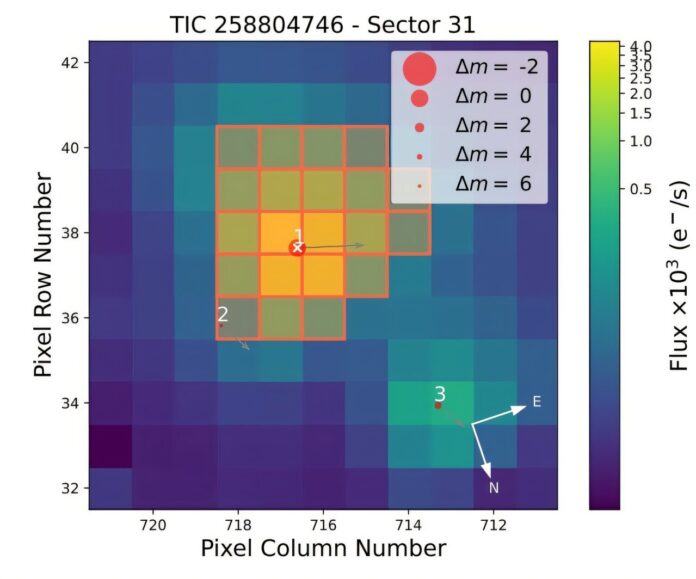Using the Transiting Exoplanet Survey Satellite (TESS), an international team of astronomers has detected a new exoplanet orbiting a nearby star. The newfound alien world, designated TOI-2431 b, is comparable in size to Earth and has a very short orbital period. The finding was reported in a research paper published July 11 on the pre-print server arXiv.
NASA’s TESS monitors about 200,000 bright stars near Earth, looking for temporary drops in brightness caused by planetary transits. Since its launch in April 2018, the satellite has identified more than 7,600 candidate exoplanets (TESS Objects of Interest, or TOI), of which 638 have been confirmed so far.
Now, a team of astronomers led by Kaya Han Taş of the University of Amsterdam in the Netherlands, reports the confirmation of another TOI monitored by TESS. According to the paper, a transit signal has been detected in the light curve of TOI-2431—a star of spectral type KV7 located some 117 light years away. The planetary nature of this signal was confirmed by follow-up ground-based observations.
“We have confirmed the ultra-short period planet TOI-2431 b using a combination of photometric transit data from TESS, precise radial velocity observations with the NEID and HPF spectrographs, and ground-based speckle imaging with the NESSI instrument,” the researchers wrote.
TOI-2431 b has a radius of about 1.53 Earth radii and is 6.2 times more massive than the Earth, which yields density at a level of 9.4 g/cm3. The planet orbits the host star every 5.4 hours, at a distance of some 0.0063 AU from it. The equilibrium temperature of TOI-2431 b was calculated to be approximately 2,000 K.
Based on the derived properties, the astronomers classified TOI-2431 b as an ultra-short period (USP) Earth-sized alien world. It is one of the shortest period exoplanets so far detected.
The proximity of TOI-2431 b to its parent star and the relatively high equilibrium temperature, suggests that the surface of the planet is likely molten. Moreover, TOI-2431 b is likely tidally deformed, with its shortest axis being about 9 percent shorter than its longest axis.
The authors of the paper also estimated a tidal decay timescale for TOI-2431 b, which was found to be about 31 million years. This is the shortest tidal decay timescale compared to other known USPs.
When it comes to the host star TOI-2431, it is about two-thirds the size and mass of the sun. The star is estimated to be two billion years old and has a metallicity at a level of -0.02 dex. The effective temperature of TOI-2431 is approximately 4,109 K.
Summing up the results, the scientists noted that TOI-2431 b is a suitable target for phase curve observations with the James Webb Space Telescope (JWST), which could shed more light on the planet’s surface composition, and may answer the question of whether or not it has an atmosphere.
Written for you by our author Tomasz Nowakowski,
edited by Sadie Harley, and fact-checked and reviewed by Andrew Zinin—this article is the result of careful human work. We rely on readers like you to keep independent science journalism alive.
If this reporting matters to you,
please consider a donation (especially monthly).
You’ll get an ad-free account as a thank-you.
More information:
Kaya Han Taş et al, An Earth-Sized Planet in a 5.4h Orbit Around a Nearby K dwarf, arXiv (2025). DOI: 10.48550/arxiv.2507.08464
Journal information:
arXiv
© 2025 Science X Network
Citation:
New Earth-sized exoplanet orbiting nearby star detected (2025, July 21)
retrieved 21 July 2025
from https://phys.org/news/2025-07-earth-sized-exoplanet-orbiting-nearby.html
This document is subject to copyright. Apart from any fair dealing for the purpose of private study or research, no
part may be reproduced without the written permission. The content is provided for information purposes only.



